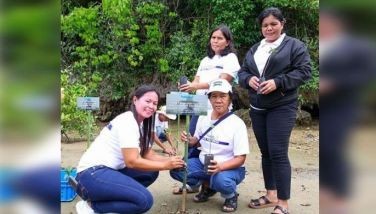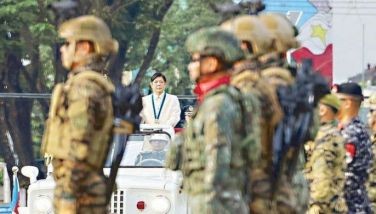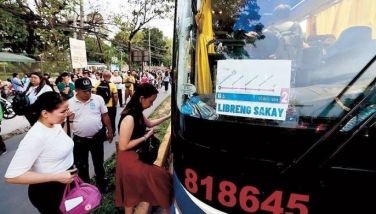A life full of color & drama
Manila, Philippines - Once upon a time, a young couple fell deeply in love with each other and went on to get married against their parents’ wishes. The woman Cecilia Gonzalez Favis and the man Jose Gonzalez Gomez were cousins, who belonged to an old-rich family that owned one of the biggest, if not the biggest, hacienda in the Philippines, the Hacienda Esperanza in Bautista, Pangasinan. Against all odds, they turned a deaf ear to gossip of clan and friends and moved to Baguio to raise a family.
On May 23, 1947, their first baby was born and christened Margarita F. Gomez. Now, relatives were almost sure there would be something wrong with the baby. But she seemed all right, nothing abnormal with her physical features nor with her mind. What they didn’t know was that the tyke, Maita, didn’t grow up a typical member of the family, for she didn’t act like a true-blue burgis. Nobody understood why she was always getting lost somewhere, why she kept befriending the neighbors, the vendors, the Igorots, and giving away her clothes and shoes, why, above all, she enjoyed having dinner with them in her parents’ house, instead of inviting only those of her class. Perhaps some figured she was “weird,” after all.
Soon, Maita, the eldest of five girls and two boys, was sent to Manila to study there, where she lived with her maternal grandmother Lola Ramona in Malate. Later, her sister, parents, and whole family followed, stayed in Ramona Apartments, and then moved to San Lorenzo Village, Makati.
At Assumption High in San Lorenzo, Maita had an average grade of 97-98. But when a nun tore the hem of Maita’s skirt because it showed half her knee, Maita didn’t want to go back to Assumption. She transferred to St. Scholastica’s College in Manila, where soon, the sisters talked to Maita’s mother to have Maita moved to yet another school.
At St. Scho, for the first time, she went downtown, and her grades slid. Because her friends were like her, “living in a glass bubble,” she was surprised students went to school so that they could help their parents. “Nagulat ako. St. Scho pa lang iyon, ha!”
This tall, thin, gangly, awkward teenager never thought she was pretty. She was also naughty, boyish, different in appearance, quite unorthodox. Overprotected by her parents, Maita, together with her sister, was made by her father to read a certain number of books before they could go to the movies. At 12, Maita read Henry Miller, and at 16, Nietzsche. She also read Thomas Hardy, Virginia Woolf, Jane Austen, William Faulkner, Emily Bronte, Return of the Native, Wuthering Heights, Camus, Sartre, James Joyce, Aldous Huxley, Saul Bellow, and Earl Stanley Gardner and the mysteries. Besides reading, she enjoyed summer vacations in Pangasinan.
At 13, Maita rammed through a glass door on Christmas Eve and was rushed to San Juan de Dios Hospital in San Juan. She went home after she was stitched on her forehead, her eye, and her arms. After lunch on Christmas Day, she went to a movie, a 5’7” youth all scars and bandage, turning the left side of her face away from people. Now, she wishes to see that doctor who did a very good job healing her face: “I have to thank him. I always like to go back to people who helped me, whether they like me or not.”
Lola Ramona gave Maita a high school graduation gift, a free four-month trip around world — to Asia, Africa, Europe, the Americas. “It was the best education. I learned many different ways of looking at things, and developed a less parochial attitude,” enthuses Maita. She wanted to study abroad, but her father said, “No,” so that he could keep an eye on her.
The intellectual Maita never related to her mother’s role. She dreamed of being a psychiatrist. Again, the father objected: “You’re just going to get married.” She was allowed to take up pre-med, where her average grade was 1.25, which was higher than what was required for female students. And for the first time, she took the bus.
Still circulating in high society, Maita was spotted by Pitoy Moreno in a party. He asked the mother of Conchitina Sevilla to ask Maita’s mother if Maita could model for Pitoy once. Maita did, not knowing how to model clothes. There was a contest in Australia to study modelling and work, with free board and lodging and allowance. In Australia, she learned hard work. She was on call, attended workshops, ate at 7 a.m., ate standing up at 3 to 4 p.m. For less than a year, she had a good experience in Hong Kong, Australia and the Philippines. When she came back, she modeled every day for a year, and went with Pitoy to Europe, and learned professionalism and some PR skills.
Maita was also selected as one of Manila’s Five Prettiest. Then, on a modeling stint at the Araneta Coliseum, the Top 10 models were chosen and interviewed. None of the models knew what was happening until Maita was named Miss Philippines and was to join the Miss International contest in London. She refused, but finally left four days later with Pitoy, lost her luggage and was almost late for the pageant.
What happened was Ferdie Villar wanted to sell his Miss Philippines franchise. But he couldn’t without first sending a candidate to the Miss International tilt, because if he didn’t, he would lose his franchise and wouldn’t be able to sell it. Maita lost, and Villar sold the franchise to Stella Marquez Araneta.
After modeling for one year, Maita, then 20, got hitched in l968. When her boyfriend proposed marriage in a party, Maita consulted friends, then said yes. In the middle of the night, they looked for Mayor Antonio Villegas in Forbes Park to wed them. Then, Mayor Villegas went to Maita’s parents and informed them, “I just married off your daughter.”
Maita stayed for one year in Philadelphia, where hubby finished schooling, while Maita cooked their meals. Then, it was another year in New York, where hubby worked as a trainee in a stockbroker firm, studied in a business school and passed the board exam. He was hired by a stockbroker company in the Philippines, and the two returned in 1970, with Maita pregnant. Here, daughter Melissa Perez Rubio was born.
They stayed a few months in Lola Ramona’s Ramona Apartments, and since Maita’s mother-in-law was a businesswoman, Maita’s husband didn’t expect Maita to be a housewife. So, Maita went back to U.P.
At U.P., the bedrock of student activism, Maita befriended poor students, went to her first demo against the Vietnam War, got her first exposure in the rural areas on a medical mission, where she collected medicines, donations, etc. Hubby didn’t like Maita’s interests nor her speaking to people in Tagalog, and complained that “my wife has become a communist.” From AB, pre-med, she shifted to Philosophy. “The movement appealed to all my deepest beliefs. My involvement translated ideals into action.”
When martial law swooped down, Maita’s husband forced her to choose between him and her activities. Maita hadn’t planned on leaving him, but she chose out. She ran to her father, who lived a block away, but her father also made her choose. She left home.
She went underground, improved her Tagalog by reading Liwayway, worked for an underground paper, and ate fish and bagoong. In 1973, she was arrested in Baguio, then transferred to Camp Olivas. She was not tortured, although she kept mum. She soon escaped prison and lived in the countryside from 1973 to the ’80s. Maita recalls, teary-eyed, how the people sheltered her in times of danger, how they shared with her what little they had.
States Maita: “Decent poor people have incredible courage because they face the same vicissitudes in life we face without nothing, without a bank account, without connections, no electricity, no back-up system. They’re so incredibly brave just to face their day-to-day life. I have come to appreciate their intelligence and their scientific knowledge. They live with nature. They know the laws of nature so intimately. I find this fascinating and admirable. I find that the poor are such generous people. Really, they are the children of God.”
She lived “an inspired life” for three years in the Bicol mountains and three years in Central Luzon. So, when she was transferred to Metro Manila with a reward on her head, she felt demoralized. She was captured, brought to a hospital in Camp Crame due to illness, and was placed under house arrest. She was so despondent she shacked up with another guy, for what reason, none of her friends could fathom.
She became active again when Ninoy Aquino was killed. She organized WOMB (Women for the Ouster of Marcos and Boycott) and GABRIELA. She campaigned abroad against Ferdinand Marcos. She was spending so much time helping others, her then current partner again forced her to choose — him or her friends. Naturally, she chose out.
Maita went on to co-found Abanse Pinay! and ran in 1987 as representative of the fifth district of Manila under Liberal Party-Kaiba. She lost, partly because she registered only Margarita Bartolome and did not include her more famous name, Maita Gomez.
After 10 years of devotion to the nationalist movement, she got into other various things like helping shape the pilot Women’s Studies at St. Scholastica’s; finishing A.B., Sociology at the Polytechnic University of the Philippines; turning to religion, living like a hermit, and rediscovering her family of five children (Melissa, now 31 and married; Luis, 26; Antares, 21; Kris, 20; Michael, 13); taking up M.A. in Development Economics at U.P.; working at MERALCO; teaching at De La Salle University and St. Scholastica’s; and writing research studies and columns and articles in English and Filipino on women and war crimes, marketing, environment, etc.
Less than a year ago, Maita got 15 women to invest in Women Work Well Foundation to help women find paying jobs. Her office, where she’s involved in management, gives training for applicants who may work in offices as janitor, gardener, driver, and the like. Maita may have quit the movement, but she’s still an activist. “I believe that every person has to live for something greater than you or your life becomes so petty,” she explains.
Now, she’s happy being of help to the needy and being herself. She’s kind but a strict boss. She spoils her children, but her children know when she really puts her foot down. Tired of being used, she avers: “I hate public attention simply because all of it is objectification…My self-esteem is not tied up with publicity at all. I’m an accidental public figure. I never sought being a public figure.” And that’s why she has junked any idea for a biopic on her.
Maita has no vitriolic bone in her, just honesty all over. “I’m a burgis who’s not a burgis, masa who’s not masa. I’m neither one, I’m a bit of an island...I can be very kind and very gullible. But I can also be harsh. I’m not confrontational, but I’m always civil. If you don’t know me, then, okay, don’t know me na lang!”
Cecilia Favis Gomez, 85, is now quite at peace, knowing that her daughter Maita has returned to the Roman Catholic faith, is safe with her own children in Ramona Apartments, is, above all, glad doing what she wants to do. They visit each other as often as possible — Doña Cecilia lives only a few doors away —converse in Spanish, and share newbits and recipes. Maita Gomez has come a long way, and nobody knows where she’ll turn next.
(The Leader, February-March 2003)
Update
On the afternoon of July 12, 2012, Maita Gomez was found dead by her son in her house in Quezon City. She had had a heart attack while sleeping. Even in death, Maita chose to keep a low profile.
Beneath the calm demeanor, though, was an ever questioning mind and a very restless spirit. On April 16, 2009, according to the Wikipedia, Maita became founding co-chair of the Makabayan Koalisyon ng Mamamayan (Makabayan). The coalition is composed of partylists Bayan Muna, Gabriela, Anakpawis, Kabataan, Courage, Migrante, Alliance of Concerned Teachers, and Katribu. (This, she did not divulge in my last interview with her, maybe because she was an expert in united-front work.)
I last talked to Maita in February 2012. As of that time, Maita had gone back to school to earn her Bachelor’s and Master’s degrees. She then taught at the De la Salle University School of Business and Economics and at the University of the Philippines-Manila Department of Social Sciences. She liked teaching because it’s “nice to be in touch with young people, but I like to build.”
She became active at the Action for Economic Reforms (AER) and urged that local government units should effect just tax collection in order to generate much-needed revenues. She concentrated on her work at Bantay Kitá, a network of civil-society organizations that advocate transparency in the extractive industries such as mining. Dealing with ecological issues, Maita travels a lot around the Philippines to monitor, research and give talks on how to protect, disabuse and try to find solutions to problems affecting, say, minerals and miners.
Maita shunned publicity to the point that she tended to forget anything written about her. No matter how much a public figure she was, she would rather dote on her grandchild in Manila and two in the province. She led, she said, a “very quiet life” as a homebody, and prayed every day.
But who knows, she might yet stir some sort of revolution somewhere in the beyond.
(Editor’s Note: This article is from a forthcoming book Darna & Other Idols by Marra PL. Lanot, a collection of profiles of personalities, several of which were first published in The Philippine STAR, published by Anvil.)
- Latest
- Trending



























 Exclusive
Exclusive





